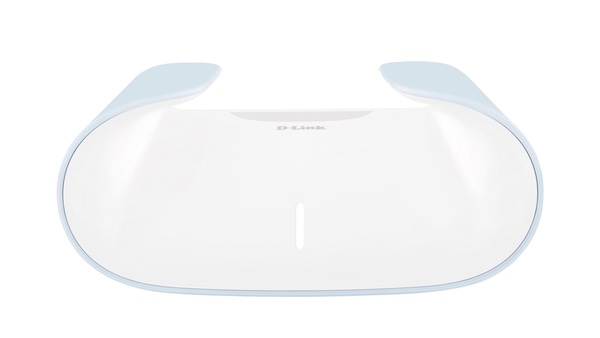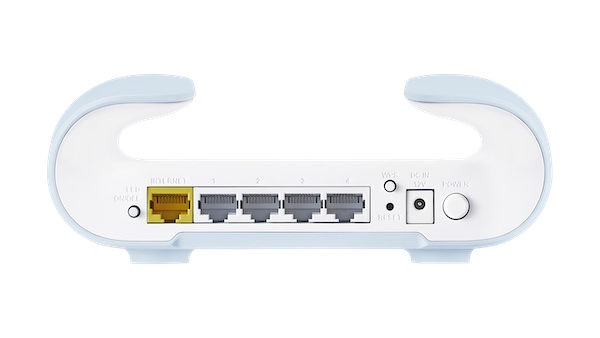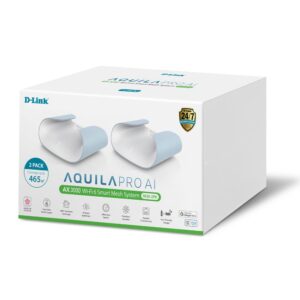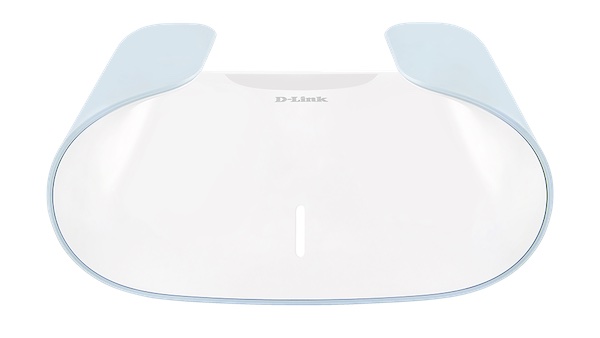D-Link AX3000 wi-fi 6 smart mesh system (two pack $AU399.95, $NZ499)
One of the first things you’ll notice about D-Link’s Aquila Pro AI AX3000 wi-fi 6 mesh system is the look of its two M30units. This mesh system is no ordinary looking mesh system, all boxy and angled.
It has curves and angles. It looks modern and sleek.
Design and Aesthetics.
You’ll see from the images that the two M30 units have sweeping curves, with white coloured main body broken up by a nice teal blue (or maybe it’s light grey) on the curved top panels. They kind of look like a manta ray if you squint your eyes a little.
Each unit has one LED on the front to indicate connectivity status and at the rear you’ll find four gigabit ethernet LAN ports, one gigabit ethernet WAN port, WPS button, reset button and power on/off.
They’re honestly pleasant to look at compared to what the majority of router/extender units look like and fit nicely into my lounge: They’re not units that you’ll need to hide in a cupboard and keep out of sight.
Functionality and Coverage.
With five internal antennae (2 x 2.4GHz and 3 x 5Ghz), and capable of speeds of up to 574Mbps on the 2.4GHz range and 2603Mbps on the 5GHz range, the units can either be used as a router to create a home network or as a range extender to increase coverage of an existing wi-fi network.
I have a single-storey house with my current router in the garage so there doesn’t tend to be too many dead spots but thanks to internal walls, doors, tiles and god knows what else, the signal in the dining room is much weaker than the signal in the bedrooms. D-Link says the two pack can cover up to 450sqm so plenty of coverage for my home.
As mentioned earlier, you can use the M30 units as either a router or range extender. I decided to just test the extender capabilities at this stage but will test using one as a router and one as an extender soon.
Installation and Testing.
Set up was super simple using the WPS buttons on my router and one of the units to establish the link between the two. After a few minutes, the LED on the front of the unit was a solid white, meaning a connection had been established, and I could move it to where I wanted it. I placed the unit underneath my TV on the entertainment unit in the lounge, close to where all my devices are.


D-Link says the system will provide a reliable wireless connection everywhere in your home using its “AI wi-fi optimiser” and provides “360 degrees spherical coverage”, and usually anything prefaced by the letters “A” and “I” seems to be marketing bollocks, but the D-Link gave me just what it said on the box: A rock solid, stable wi-fi connection right across the entire house.
I was able to watch Netflix and Amazon Prime flawlessly via the unit, with silky smooth performance, as well as download games to my PC, Steam Deck and consoles effortlessly.
I wouldn’t recommend using both units as an extender at the same time, though, as I tested that and it caused one of the units to have an unstable connection, which was less than ideal. If you’re going to use both units set one up as the router then the other as the extender.

Overall Opinion.
I used Ookla Speed test to check the speeds, and from my office, which backs onto the main living room, I was getting download speeds of 263Mbps and upload speeds of 253Mbps. From the bedroom unit, I was getting speeds of 712mbps down and 340Mbps up, which blew me away to be honest (although, to be fair, it’s only a few metres from my bedroom door to the garage where the main router is).
All and all, my experience with D-Links Aquila Pro AI AX3000 wif-fi 6 smart mesh system was an extremely positive one – and consistent with previous experiences with D-Link products – offering easy set up combined with rock solid performance for a pretty decent price, too.
Plus, they look pretty nice, too, which is an added bonus.




